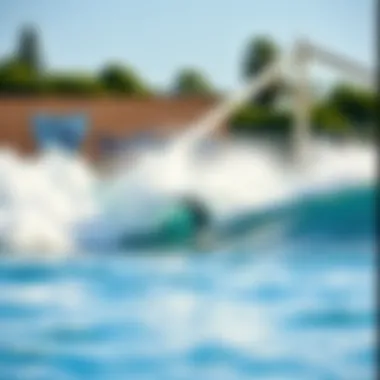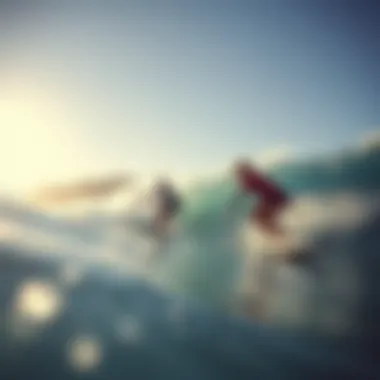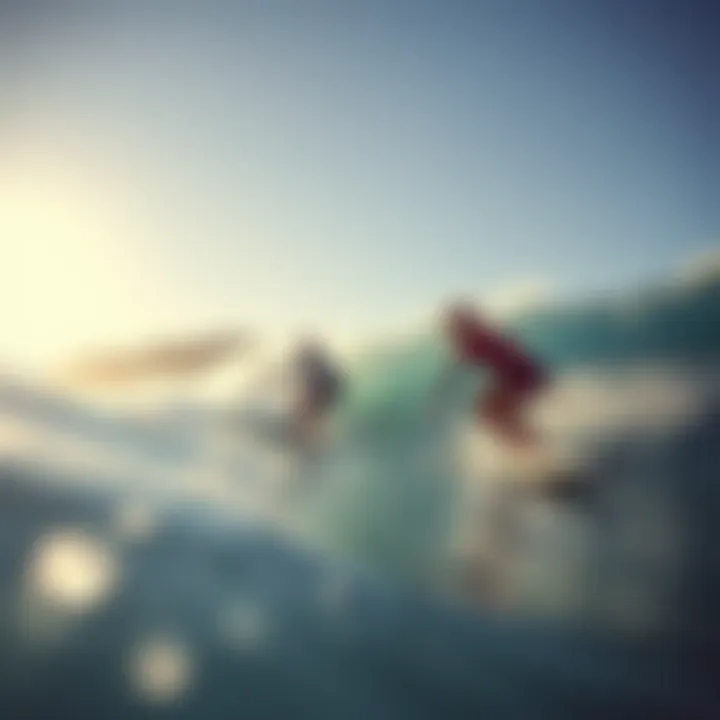Exploring the Dynamics of Fake Wave Surfing


Intro
The world of surfing has always been intertwined with the rhythm of the ocean, but now it’s experiencing a shift that could change the very essence of the sport. Fake wave surfing, or artificial surfing, is becoming a hot topic among enthusiasts and newcomers alike. This phenomenon taps into advanced technology to create waves in controlled environments, a stark contrast to the untamed natural surf breaks. For many, this marks the dawn of a new era, where anyone can ride a wave regardless of their proximity to the coast.
In this article, we’ll explore the many facets of fake wave surfing, understanding the tools of the trade and how they reshape experiences for both seasoned surfers and those just beginning their journey on the water. We’ll navigate through the technology behind these man-made waves, compare the dynamics of artificial versus natural surfing, and assess how this trend is rippling through popular culture. With safety considerations and gear adaptations at the forefront, we aim to provide insights that will empower all surfers—whether they’re waxed up and ready or just thinking about paddling out.
So, let’s get our feet wet and dive into the essential gear needed for this unique surfing experience.
Gear Essentials
To fully enjoy the ride on artificial waves, it’s vital to equip yourself with the right gear. Not all surfing equipment is created equal, and understanding what is most effective in a fake wave environment can significantly enhance your performance. Here’s a rundown of essential gear for both novices and experienced riders.
Top Picks for Watersports Equipment
- Surfboard:
- Wetsuit:
- Leash:
- Wax:
- Shortboards are often preferred in artificial surf parks due to their maneuverability. Something like the Firewire Dominator is well-regarded for its performance on both natural and man-made waves.
- For a more forgiving experience, a fish-style board can also work wonders, offering stability and easier paddling.
- A good wetsuit is non-negotiable. The temperature of artificial wave pools can vary, so something like the O'Neill Hyperfreak Series wetsuit can provide flexibility and warmth when needed.
- Always make sure to have a reliable leash, like the Dakine Kainui. It keeps your board close and prevents accidents.
- Don’t forget board wax! A good grip is essential, especially when the waves are consistently created. A wax like Sex Wax can keep you upright and balanced.
Maintenance and Care Tips for Gear
Caring for your gear can prolong its life and maintain performance:
- Always rinse your equipment with freshwater after surfing. This prevents salt and chlorine buildup, especially important in artificial settings.
- Store your board in a cool place away from direct sunlight to prevent warping.
- Check your wetsuit regularly for any leaks or tears, and repair them promptly to keep it functional.
A little attention to maintenance can go a long way in ensuring your gear stays in top notch condition, making it easier to focus on what really matters—catching those perfect waves.
Techniques and Tips
While gear is crucial, mastering the techniques of fake wave surfing can elevate your game tremendously. Whether you're just setting out or looking to sharpen your skills, here are some pointers.
Beginner Tips for Each Watersport
- Start slow; get accustomed to paddling in the pool before trying to catch a wave. Practice popping up and balance on the board to build your confidence.
- Attend a class or workshop run by experienced instructors. Learning from pros can provide valuable insights on techniques and safety.
Advanced Techniques for Skill Enhancement
- Work on your positioning. In an artificial wave, you have more control over when and where you catch the swell. Practice finding the sweet spot early on.
- Experiment with turns—cross-stepping or switching stances at just the right moment can add flair to your ride.
Culmination
The emergence of fake wave surfing is reshaping the surfing landscape. It democratizes access to surfing, allowing people to experience the thrill, regardless of their geographical locus. By understanding the essential gear, its maintenance, and the techniques to master this form of surfing, both novices and veterans can participate meaningfully in this evolution of surf culture. As we look to the future, the convergence of technology and watersports opens up a dialogue that's sure to engage surfers around the globe.
For deeper dives into related topics, consider visiting Wikipedia's surfing page or joining discussions on Reddit's surfing community. Happy surfing!
Preface to Fake Wave Surfing
In the ever-evolving world of watersports, fake wave surfing is carving out a unique niche. This phenomenon embraces the allure of surfing while introducing artificial wave technology, enabling enthusiasts to ride waves with unprecedented consistency and safety. Understanding fake wave surfing goes beyond mere enjoyment; it taps into broader trends in adventure sports, technology, and community.
Defining Fake Waves
Fake waves, simply put, are waves created through artificial means, specifically designed to simulate the natural conditions found in the ocean. These waves can vary significantly in shape, height, and frequency, depending on the technology employed. While picturesque beaches and thrilling ocean swells will always hold their charm, artificial waves bring a host of benefits that make them increasingly appealing.
With a controlled environment, surfers have the power to refine their skills without the unpredictability of ocean waves, ensuring that each ride is more predictable. This reliability boosts confidence, especially for beginners looking to catch their first wave. More advanced surfers also find value in practicing high-level maneuvers repeatedly, without the varying conditions that natural waves typically present.
The Growing Popularity of Artificial Waves
The terrain of surfing is shifting, and artificial waves are leading the charge. Over recent years, the number of surf parks and artificial wave systems sprouting around the world has skyrocketed. A key driver of this growth is accessibility; individuals from all walks of life, including those who may have never set foot on a surfboard, can now partake in this exhilarating sport. With developments in wave tech, even cities far from oceans can host surf-friendly venues.
This boom in popularity speaks volumes about shifting leisure trends. People are looking for experiences that offer excitement and community engagement. Additionally, the rise of artificial wave technology supports sustainability in watersports, making it possible to enjoy surfing activities without heavily impacting natural environments. Each visit to an artificial wave park can be an opportunity to focus on skill development and social interaction, ensuring that both the community and individual surfers flourish.
Artificial waves: Bridging the gap between surfers and non-surfers, making the sport accessible to everyone.
As artificial wave technology continues to progress, we can anticipate even more innovations that enhance the riding experience. These advancements not only cater to those wishing to hone their skills but also provide entertainment for spectators, broadening the overall appeal of surfing as a sport. Thus, as fake wave surfing rises in the ranks of popular activities, it signals a new chapter in the historical narrative of traditional surfing, redefining what it means to ride a wave.


The Technology Behind Artificial Waves
The technology driving artificial waves has indeed become a significant part of the surfing experience, both for avid surfers and those new to the sport. This development not only enhances accessibility but also provides a steadier and often safer environment for surfing. The machinery behind these innovative setups can simulate conditions that would typically require a trip to ocean hotspots, helping to democratize the sport. Consequently, understanding this technology is essential for grasping the changes within the surf culture and the future of recreational surfing.
Mechanics of Wave Generation
Artificial wave generation operates on principles rooted in engineering and hydrodynamics. At its core, the technology typically involves using mechanical pumps and pneumatic systems to push water into the desired shapes and forms. The waves created can differ tremendously in size, speed, and shape.
One commonly used method is the pneumatic system, which utilizes air to create wave-like forms. These systems can be finely tuned to produce desired wave characteristics, allowing for customization like timing and frequency—important elements for both novice and competitive surfers.
Another method involves the use of hydraulic pumps that can manipulate water flows in a structured environment. This technology allows for greater flexibility in wave shapes, accommodating different skill levels. These mechanics, when introduced into controlled environments, can simulate an ocean's varied conditions, producing experience-rich environments for surfers.
Types of Wave Pools
The artificial wave surf industry has birthed several specialized types of wave pools, each tailored to different surfing experiences. Here, we’ll highlight a few key designs:
Static Wave Pools
Static wave pools create a single, uniform wave pattern, often favored for beginner surfers. Their main characteristic is predictability; the wave formed is consistent, allowing learners to practice safely without unexpected variations. This simplicity makes such pools immensely popular, particularly in locations where beginners might be hesitant to try the ocean. However, a downside lies in their inability to provide a variety of wave types, which can limit the experience for more proficient surfers.
Dynamic Wave Systems
Dynamic wave systems are engineered to replicate the dynamic surf conditions found in the ocean. Unlike static pools, they can produce waves of varying sizes and shapes, adapting to the strengths and weaknesses of the surfers riding them. The key characteristic lies in their adaptability, which draws a wider audience from all skill levels.
The unique feature of dynamic wave systems often includes multiple settings that can change wave characteristics at the push of a button. While more advanced and offering richer surf experiences, these systems also come with higher operational costs, which can influence their accessibility and sustainability in various regions.
Surf Ranches
Surf ranches represent the pinnacle of artificial wave technology, creating extensive setups often resembling theme parks for surfers. These locations are characterized by immense wave pools designed to generate high-quality waves in a variety of formats, catering to professional surfers and enthusiasts alike. The benefit of surf ranches is evident; they provide a controlled environment that can host competitions and various surfing events.
Nonetheless, the significant expenditure needed to build and maintain surf ranches often raises questions about sustainability and economic viability. They position themselves as elite surfing experiences, sometimes straying away from inclusivity for everyday surfers.
Overall, each of these wave pool technologies plays a crucial role in shaping the landscape of artificial wave surfing. Understanding their mechanics and implications helps to inform surfers about where they might best fit within the ever-evolving realm of surf culture, ultimately guiding them to suitable environments tailored to their individual skills and preferences.
Comparing Natural and Fake Wave Surfing
In the realm of watersports, the conversation surrounding natural and fake wave surfing has gained momentum as enthusiasts seek unique experiences. It’s essential to unpack the nuances of both types of surfing to understand their implications better. While natural waves harness the sheer power of the ocean, artificial waves offer a controlled environment where skill development is a priority. Therefore, exploring the differences in environmental factors, wave quality, and consistency becomes paramount in guiding surfers to make informed choices tailored to their needs.
Environmental Factors
When diving into the environmental factors, one must consider how different conditions play an influential role in the surfing experience. In traditional surfing, natural waves depend on factors like wind, tide, and underwater topography. This unpredictability can lead to exhilarating sessions or, conversely, less than ideal conditions. Surfing in places like Hawaii or California often presents surfers with varying conditions that require adaptability and skill.
On the flip side, fake wave environments are meticulously engineered. Facilities like Surf Ranch in California utilize advanced technology to simulate waves, allowing surfers to ride consistent swells regardless of external conditions. This predictability is beneficial for learners and seasoned surfers honing techniques without the unpredictability of the ocean.
However, there are environmental considerations here too; these artificial setups require resources and maintenance, raising questions about sustainability and their carbon footprint. Without a doubt, understanding these factors can deeply enrich one’s perspective on both worlds of surfing.
Wave Consistency and Quality
When it comes to wave quality and consistency, the differences between natural and artificial surfing become strikingly clear. Traditionally, natural waves can vary wildly—some days surfers may get breathtaking rides, while on others, the conditions might be too choppy or calm.
In contrast, artificial waves are engineered to deliver consistent performance. Many fake wave pools generate a predictable swell that allows surfers to concentrate purely on their technique. For instance, the wave generation technology at the aforementioned Surf Ranch produces swells that maintain a certain height and shape, catering to all skill levels.
"The ability to ride a well-formed wave repeatedly can significantly enhance performance for surfers, allowing them to perfect their style and tricks without the anxiety of unpredictable conditions."
However, some purists argue that the thrill of catching a wave in the wild cannot be replicated in a pool, citing the energy of the ocean and the nuances involved in reading waves. Therefore, while fake wave surfing offers controlled environments, there’s a romantic allure tied to the raw nature of ocean waves that’s hard to overlook.
In summary, comparing natural and fake wave surfing unravels a spectrum of benefits and challenges for surfers. As technology continues to evolve, enthusiasts in paddlesports and related fields must assess both options’ merits in crafting their surfing journeys. The insights gleaned will undoubtedly inform the surfing community’s approach to cultivating skills and choice in locations.
Cultural Implications of Fake Wave Surfing
The surge in fake wave surfing has created a new cultural paradigm within the surfing community. This dynamic shift holds several layers of significances that go beyond mere recreation. It transforms perceptions about surfing, accessibility, and relationships between surfers and their environments. Understanding these implications can enrich the surfing community and inform future developments in artificial wave technology.
The Shift in Surf Culture
In the past, surfing has been viewed through a very curated lens; it's often painted as an exclusive realm governed by the elements of nature. But fake wave surfing is flipping that narrative on its head. Now, surfers can catch a perfect wave in a controlled environment, removing much of the unpredictability that has traditionally defined the sport. The ease of access to perfectly engineered waves attracts a diverse demographic, including those who may have had limited exposure to surfing in the past.
This shift is reflected in how surf culture is evolving. Fake wave pools are popping up in urban environments, sometimes miles away from the ocean. These locations serve as hubs where people gather not just to surf, but also to socialize, train, and celebrate surfing culture. It's not just about the ride anymore; it’s about community engagement and inclusion. In many outcomes, new friendships blossom and the sport’s demographics diversify, which is a welcome change in a culture often criticized for its homogeneity.
"Surfing has always been more than a sport; it's a lifestyle. Fake wave surfing opens it to people from all walks of life, redefining who can be a surfer."
Accessibility and Inclusivity


Another significant cultural impact of artificial wave surfing is how it democratizes access to the sport. Traditionally, one had to travel to coastal areas and face challenging weather conditions and unpredictable surf to engage in surfing. Now, with artificial waves, the barriers are less daunting.
Consider these points of accessibility:
- Affordable: Many artificial wave facilities offer package deals that make surfing more affordable. People can purchase day passes or memberships, allowing regular access without the financial strain of coastal travel.
- Skill Development: For newbies, these pools are ideal learning environments. They offer consistent waves that allow trainees to practice their skills without worrying about the elements or wave intervals.
- Facilities: Improved amenities, like changing rooms, showers, and dining options, create an inviting atmosphere that caters to both surfers and spectators.
This inclusivity extends beyond novices. Seasoned surfers are finding space to hone their skills in a controlled environment, working on maneuvers that require specific wave types that may not be easily found in the ocean. This dual benefit means you often see a mix of pro and beginner surfers sharing the same pools, learning from each other, and fostering a supportive surfing culture.
As artificial wave technology continues to advance, we may find ourselves at the dawn of a new surfing era where surf culture thrives on inclusivity, community, and innovation.
Safety Considerations in Fake Wave Environments
In the thrilling world of surfing, both natural and artificial environments come with their set of challenges. When you step into a wave pool or an artificial surf venue, safety considerations are paramount. These man-made shores are generally designed to offer a controlled environment, but they'll never be devoid of risks entirely. From the equipment used to the infrastructure that supports the waves, the emphasis on safety cannot be understated.
A key aspect of surfing, whether in the ocean or a pool, is managing the unexpected. Fake wave environments can provide ideal conditions that may entice surfers of all levels, but understanding the potential hazards can make for a more enjoyable experience. Accident prevention and health management strategies must be a core part of the artificial surfing narrative, ensuring that participants minimize risks while enjoying the thrill of riding.
Accident Prevention Strategies
While the glossy allure of artificial waves might suggest a low-risk scenario, that’s often a misconception. Here are essential strategies to ensure a safe surfing experience:
- Pre-Surf Briefings: Before hitting the waves, many venues conduct briefings. These often cover the pool layout, possible hazards, and wave behavior. It’s vital to pay attention during these sessions.
- Check Your Gear: Always inspect your surfboard and any other equipment. Look for cracks or damage. A faulty board can complicate even the simplest maneuvers.
- Know Your Limits: Each surfer has a different skill level. Don’t overestimate your abilities. If the wave is too powerful or the environment feels off, it’s usually best to sit it out.
- Buddy System: Surfing with a partner not only makes it more enjoyable but can also enhance safety. Your buddy can help in case of an emergency or if someone needs assistance.
- Follow the Rules: Surf parks often have specific rules, like designated flow areas or timing sessions. Adhering to these regulations can significantly reduce the likelihood of accidents.
"Safety first means you can surf wild later."
Health Risks and Management
Even in a controlled environment, health risks do exist. Here’s what you ought to keep in mind:
- Impact Injuries: A wave pool can still produce strong currents and waves. Collisions with other surfers or equipment can lead to bruises, sprains, or worse. Wearing protective gear like helmets can mitigate this risk.
- Water Quality: Unlike the ocean, wave pools maintain a chemical balance. However, it's essential for surfers to be mindful of water cleanliness. Skin irritations and infections can occur if the water is not adequately treated.
- Dehydration: Surfing is physically demanding, and many may forget to hydrate properly. Make sure to drink plenty of water, even if you’re not feeling thirsty.
- Sun Exposure: If the venue is outdoors, it’s crucial to protect your skin. Sunscreen, rash guards, and hats can help prevent sunburns and long-term skin issues.
Essential Gear for Fake Wave Surfing
When it comes to fake wave surfing, having the right gear can make the difference between an exhilarating session and a frustrating one. This tailored equipment is essential not just for performance but also for safety and comfort, ensuring that both seasoned surfers and newcomers can enjoy their time on the water. As artificial wave technology gains traction, understanding how to select and use the appropriate gear becomes increasingly important.
Board Selection for Artificial Waves
Choosing the right surfboard is a pivotal part of the fake wave surfing experience. Unlike traditional surfboards designed for natural waves, boards meant for artificial wave environments often feature unique attributes that tailor them specifically to the mechanics of generated waves.
One key aspect to consider is the board's shape. A board with a wider nose and a shorter tail might work best in dynamic wave pools, granting better stability and maneuverability. Surfboards made from lighter materials can also enhance performance, allowing quicker changes in direction and speed. Some brands, like Firewire, have crafted models explicitly for these artificial environments, which blend innovation in design with cutting-edge materials.
Key Points for Board Selection:
- Length and Width: Shorter boards give you the edge in speed, while wider boards offer improved stability.
- Material Type: Opt for lightweight materials to enhance performance.
- Skill Level: If new to surfing, a longer and more buoyant board will assist in catching waves more easily.
Ultimately, your choice of board should align with your skill level and the specific type of artificial wave setup.
Wetsuits and Other Accessories
Alongside your surfboard, the wetsuit is another crucial component in your gear lineup. For fake wave surfing, the choice of wetsuit will vary depending on the water temperature of the facility. If you’re in a warmer climate, opting for a shorty or spring suit can provide comfort without overheating. On the other hand, colder waters demand full-suit options, which come in various thicknesses to accommodate temperature fluctuations.
Let’s not forget accessories like surf wax, which plays an understated yet significant role. The right wax will keep your feet securely planted on the board, ensuring that you have the grip needed to perform tricks and turns. Furthermore, leg ropes or leashes are a safety must-have. They connect you to your board, preventing it from drifting far away or posing a risk to others in the water.
Essentials to Consider:
- Wetsuit Fit: Make sure it fits snugly to avoid water flushing in and out.
- Temperature Rating: Choose a suit suited for the specific climate you’ll be surfing in.
- Additional Gear: Don’t skimp on items like surf hats or sunglasses to protect yourself from the sun during those long sessions.
"Your kit isn’t just about performance; it’s about staying safe and comfortable on the waves."
Being well prepared with the appropriate gear not only enhances your experience but also boosts your confidence on the artificial waves, ensuring every session is enjoyable and rewarding. As you dive into this exhilarating sport, paying attention to these details of your gear can make all the difference.
Training Techniques for Fake Wave Surfing
Training techniques tailored for fake wave surfing are essential as they blend the unique facets of both artificial and natural environments. The controlled setting of a wave pool allows surfers to refine their skills in a way that is distinct from the unpredictable nature of ocean waves. Understanding these methods not only enhances performance but also cultivates safety and confidence, particularly for newcomers to the sport.
Skill Development Approaches
Skill development approaches in fake wave surfing hinge on structured practice and feedback. When surfers enter an artificial wave setting, they encounter a consistent wave type, which presents an opportunity to focus on their technique without the complications of tides and swells.
- Regular Practice: Regular visits to a wave pool facilitate muscle memory and the honing of techniques. Surfers can repeatedly practice turns, tricks, and transitions, making incremental adjustments based on immediate feedback.
- Drills and Exercises: Specific drills can be implemented to target individual skills, such as paddling, catching waves, or executing maneuvers. For instance, a surfer may dedicate sessions solely to perfecting their bottom turn, gradually building up to more complex maneuvers.
- Video Analysis: Recording practice sessions and reviewing footage is a beneficial tool. Surfers can visually assess their form and receive constructive criticism, enabling them to refine their approach more effectively than during live observation alone.
- Simulating Real Conditions: Even within the controlled environment of a wave pool, incorporating challenges simulating real sea conditions, such as adjusting to varying speeds or focusing on smaller sections of a bigger wave can be invaluable. This method prepares surfers for the variability they might face when transitioning back to natural waters.
Practicing in a wave pool can help surfers build confidence to tackle the ocean waves later. The ability to replicate and master skills in a consistent environment is one big advantage that fake wave surfing offers.


Coaching Insights
Coaching plays a pivotal role in shaping a surf instructor's effectiveness, particularly in the realm of fake wave surfing. A well-informed coach enhances not only the performance of the surfer but also their enjoyment and safety on the waves.
- Personalized Coaching: Coaches who customize training sessions based on an individual's strengths and weaknesses yield the best results. This personalized approach allows for a focused development trajectory that often leads to quicker improvement.
- Proper Communication: Clear and effective communication is crucial. Coaches should provide instructions that point out both what to do and what not to do. Using simple language and visual demonstrations ensures that surfers of all levels can grasp the concepts taught.
- Building a Positive Environment: Encouragement and positivity foster a thriving atmosphere. When a coach celebrates small victories and constructive efforts, it encourages surfers to push their boundaries while feeling secure in their learning process.
- Safety Protocols: Instructors also have the duty to ensure that safety standards are followed. Reinforcing guidelines, such as maintaining a proper distance from other surfers and respecting designated areas in the wave pool, helps prevent accidents.
Ultimately, sound coaching facilitates a deeper understanding of surf dynamics, allowing for a more profound appreciation of the sport, whether on fake waves or real ones.
"The journey of mastering fake wave surfing is a combination of patience, practice, and constructive coaching. Embracing this blend transforms both confidence and technique."
Future Trends in Fake Wave Technology
The constantly shifting landscape of surfing is undeniably exciting, and one area witnessing vibrant growth is fake wave technology. As enthusiasts dive into artificial surfing, understanding where this realm is heading becomes crucial. The importance lies in how these trends can potentially reshape surfing culture and offer new experiences that novices and veterans alike can enjoy. Innovations in wave generation and the evolution of surf parks are two pivotal elements in this transformative journey.
Innovations in Wave Generation
Wave generation technology keeps evolving, and it is a game changer for the surf community. Today, artificial waves can mimic the unpredictable nature of ocean swells more closely than ever before. Several types of mechanisms are at play, ranging from pneumatic systems to hydrokinetic wave machines.
- Pneumatic Systems: These employ compressed air to create waves, offering surfers varying wave sizes and shapes. This technology presents the surfista an opportunity to choose their challenge level, much like selecting sushi from a menu.
- Hydrokinetic Machines: Utilizing water currents, these systems operate on a principle similar to underwater turbines. They can generate persistent waves by manipulating water flow, perfect for long rides without the need for ocean tides.
- Portable Solutions: Recently, portable wave-generating units are entering the market. These setups can be transported and erected anywhere, making it possible to bring the beach experience to inland cities or wherever surfers gather.
"The technological revolution in wave generation is not just about quantity; it’s about quality, diversity, and accessibility."
Surfers can expect more user-friendly interfaces and real-time customization of wave settings. Imagine being able to adjust wave height or frequency at the push of a button! This level of control will certainly attract a broader audience and possibly nurture a new generation of skilled surfers.
Evolution of Surf Parks
As artificial wave technology advances, surf parks evolve to become all-encompassing experiences rather than mere venues for wave riding. Several trends are driving this evolution:
- Integrated Facilities: Modern surf parks are enhancing their appeal with accompanying amenities like restaurants, yoga studios, and shops. These additions transform the site into a lifestyle locale, encouraging day-long visits.
- Sustainability Practices: A growing number of surf parks are investing in sustainable practices, including water recycling and energy-efficient wave generation techniques. It reflects an awareness and responsibility to minimize environmental impact while enabling surfers to indulge in their passion.
- Community Engagement: Finally, surf parks are focusing on creating community spaces that encourage local involvement. From beginner classes to competitive events, these parks are fostering connections between surfers across skill levels, enhancing the overall culture of surf.
The future is shaping up to be as thrilling as a perfect wave. As technology continues to improve and surf parks adapt to offer enjoyable experiences, fake wave surfing stands poised at the forefront of watersport innovation. This shifting tide could not only attract newcomers but also hold the attention of seasoned surfers, leading to an enriched community and an invigorated sport.
Impact on Traditional Surfing Locations
The emergence of artificial wave technology has stirred the waters of traditional surfing locations, creating ripples of change that affect both local economies and the environment. It’s no longer just about catching the perfect wave at your favorite beach—surfing culture is evolving, and this evolution demands attention. For those tied to the roots of surfing, understanding the impact of fake wave surfing on traditional locales is crucial. While it brings new surfing opportunities, like anything, there are upsides and downsides.
Economic Effects
Artificial wave parks and surf ranches are popping up like daisies in spring, and with them, promising economic benefits for local communities. These parks are akin to a surf-centric Disneyland, drawing visitors from near and far. The influx of surf enthusiasts translates into significant revenue for local businesses—think surf shops, coffee houses, and hotels.
- Job Creation: The establishment of these parks results in a demand for employees. Local startups and established businesses alike find new roles through hospitality, facility maintenance, and instruction services.
- Increased Tourism: A well-placed surf park can turn a sleepy town into a buzzing surf hub. Day trippers, weekend warriors, and even international travelers flock to these sites, eager to experience the guarantee of perfect waves. This tourism translates to increased spending in an area that may have previously struggled economically.
- Sponsorships and Events: Many surf parks host competitions and events, drawing significant attention. Sponsorship deals and partnerships flourish, resulting in greater market visibility for local brands and related businesses.
However, as with any silver lining, there can be clouds. The very presence of these artificial waves might subtly shift the classic surf culture, which could leave some traditional surfers feeling like they’ve been left out in the cold. There’s a risk that familiar surf breaks could be overrun by less experienced surfers, impacting the experience for long-time locals.
Environmental Concerns
The environmental footprint of artificial wave pools can be a double-edged sword. On one side, they are often designed to mimic natural wave patterns, which attracts attention for innovation. But the environmental implications are worthy of scrutiny.
- Water Usage: The operation of wave pools requires substantial water resources. In areas where water scarcity is a concern, this can lead to criticism from local advocates. Balancing the demand for recreational surfing with responsible water use is a nagging issue.
- Ecosystem Disruption: In some cases, the construction of a surf park may disrupt local ecosystems. Wetlands or coastal areas might be altered, potentially negatively affecting local wildlife and plant life.
- Waste Management: Increasingly large crowds mean a greater potential for litter and waste. Local authorities may face additional challenges to keep the surrounding areas clean and manageable.
“The wave park is an attraction, but the local flora and fauna lose their home. Is it worth the thrill?”
The conversation around artificial surfing and its complete impact on traditional surfing locales is not black and white. It’s a complex interplay of economic advantages, community dynamics, and environmental stakes that challenges surfers and policymakers alike to weigh the pros and cons.
As the surfing culture transforms within artificial environments, it will be essential to find ways to respect traditional surf locations while exploring the benefits that innovation brings. In understanding these dynamics, we can better navigate the present and carve a sustainable future for surfing itself.
For more insights about surf economies and environmental impacts, see Britannica's article on Surf Tourism and community discussions on Reddit's Surfing subreddit.
The End
In wrapping up, the exploration of fake wave surfing leaves us with an array of insights that shape our understanding of this growing phenomenon. First and foremost is the recognition that fake wave technology reshapes the surfing landscape by making it accessible to a wider audience. No longer is surfing a sport solely reserved for those who can travel to remote beaches or weather unpredictable ocean conditions. Instead, surf parks and artificial wave venues allow novices and seasoned surfers alike to hone their skills in a controlled environment.
Summarizing Insights
The article has highlighted several critical elements regarding the journey into artificial wave surfing.
- Accessibility: More surfers are able to enjoy the sport without needing to navigate the challenges of natural waves.
- Quality and Consistency: Surfers can expect a high level of consistency in wave quality, which can lead to improved skill development.
- Cultural Shift: The rise of fake wave surfing breeds new cultural norms and communities, where learning and sharing experiences become central.
Moreover, the environmental considerations discussed earlier shed light on the mixed impacts that such innovations can have on traditional surfing locations. By acknowledging these multiple layers, we can appreciate the dual nature of this evolution—where pros, like enhanced accessibility, coexist with cons, such as potential economic pressures on local surf spots.
The Future of Surfing
Looking ahead, the future of surfing—both artificial and natural—is poised for significant transformation. Key trends worth noting include:
- Innovative Wave Technologies: Ongoing advancements in wave generation are likely to push the boundaries of what artificial waves can achieve. More realistic waves that mimic specific coastal conditions may emerge, aiming to bridge the gap between natural and artificial experiences.
- Sustainable Practices: Eco-friendly designs and operational methods are becoming increasingly necessary as awareness of environmental impacts grows. The surf parks of tomorrow may need to prioritize sustainability to coexist harmoniously with nature.
- Integration with Traditional Surf Culture: As surfers flock to artificial venues, there's potential for fusion between traditional surfing culture and the new wave surfing communities. Expect a blend of styles, techniques, and values as both worlds learn from each other.
In essence, the dynamics of fake wave surfing not only offer a new way to experience the sport but also open avenues for discussions about its implications on culture, economy, and environmental responsibility. As we ride these synthetic waves, the journey ahead promises to be as thrilling as any ride on the ocean.



